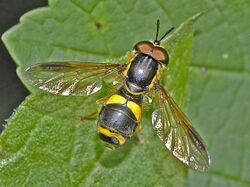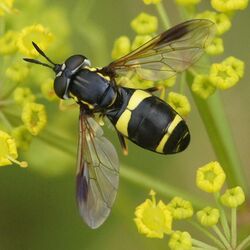Biology:Chrysotoxum bicinctum
| Chrysotoxum bicinctum | |
|---|---|

| |
| Male | |

| |
| Female | |
| Scientific classification | |
| Domain: | Eukaryota |
| Kingdom: | Animalia |
| Phylum: | Arthropoda |
| Class: | Insecta |
| Order: | Diptera |
| Family: | Syrphidae |
| Genus: | Chrysotoxum |
| Species: | C. bicinctum
|
| Binomial name | |
| Chrysotoxum bicinctum | |
| Synonyms | |
File:Chrysotoxum bicinctum.ogv
Chrysotoxum bicinctum is a species of hoverfly.
Description
Chrysotoxum bicinctum can reach a length of about 10–13 millimetres (0.39–0.51 in). This species can be distinguished by the contrasting drawings and by the relatively narrow body shape. Thorax is glossy black with two gray longitudinal stripes. Body is relatively slim, the abdomen is long, oval and black with two light yellow bands (hence the Latin species name bicinctum). As in others Chrysotoxum species antennae are relatively long. They are dark, forward pointing and longer than the head. The head is large and wide and the face is yellow and almost flat. The legs are mainly yellow. The wings are transparent, with a large, dark brown spot near the wing tip.[2] [3] [4][5]
The larvae are thought to feed on ant-attended root aphids. The adult flies can be found from May to September but they are commonest from mid-June to August. They visit a wide range of flowers.[6]
Distribution
Fennoscandia south to Iberia and the Mediterranean basin, through Central Europe and Southern Europe (Italy, the Balkans, Bulgaria) East into Turkey and European Russia then to central Siberia. It is widespread throughout Britain and Europe but normally encountered in small numbers.[7][8]
Habitat
Adults are usually found on the edges of woodland or scrub or along hedgerows.[9]
Bibliography
- Speight, M.C.D., Castella, E., Sarthou, J.-P. & Monteil, C. (eds.): Syrph the Net on CD, Issue 7. The database of European Syrphidae. ISSN 1393-4546. Syrph the Net Publications, Dublin.
- van Veen, M.P. Hoverflies of Northwest Europe KNNV Publishing 2004, ISBN:978-90-5011-199-7.
- Systema Dipterorum. Pape T. & Thompson F.C. (eds)
- Fauna Europaea
References
- ↑ Catalogue of Life
- ↑ Van Veen, M. (2004) Hoverflies of Northwest Europe: identification keys to the Syrphidae. 256pp. KNNV Publishing, Utrecht.addendum
- ↑ Van der Goot,V.S. (1981) De zweefvliegen van Noordwest - Europa en Europees Rusland, in het bijzonder van de Benelux. KNNV, Uitgave no.32: 275pp. Amsterdam.
- ↑ Bei-Bienko, G.Y. & Steyskal, G.C. (1988) Keys to the Insects of the European Part of the USSR, Volume V: Diptera and Siphonaptera, Part I. Amerind Publishing Co., New Delhi. ISBN:81-205-0080-6.
- ↑ Coe, R.L. (1953) Diptera: Syrphidae. Handbooks for the Identification of British Insects, 10(1): 1-98. Royal Entomological Society of London pdf
- ↑ de Buck, N. (1990) Bloembezoek en bestuivingsecologie van Zweefvliegen (Diptera, Syrphidae) in het bijzonder voor België. Institut royal des Sciences naturelles de Belgique, Documents de Travail 60, pp. 1-167.
- ↑ "Fauna Europaea". http://www.fauna-eu.org/.
- ↑ Peck, L.V. (1988) Syrphidae. In: Soos, A. & Papp, L. (eds.) Catalogue of Palaearctic Diptera, 8: 11-230. Akad.Kiado, Budapest.
- ↑ Stubbs, Alan E.; Falk, Steven J. (1983). British Hoverflies: An Illustrated Identification Guide. British Entomological & Natural History Society. pp. 253, xvpp.
External links
- Biolib
- Tom Gittings Chrysotoxum bicinctum
Wikidata ☰ Q232268 entry
 |


